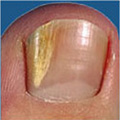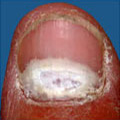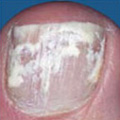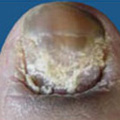What Is Nail Fungus?
Many changes in fingernails or toenails may cause people to think they have a fungal nail infection of the nails, medically known as onychomycosis. It’s the most common thing that can happen to your nails, occurring in about 50% cases of nail abnormalities. Both fingernails and toenails are susceptible to the infection, which usually manifests as discolouration and thickening of the crumbling toenails. Out of the two, toenail fungus is much more common than fingernail fungus.
Toenail fungus is an infection that gets in through the cracks formed in your nail or cuts in your skin. It can make your toenail change its colour or get thicker. As toes become warm and damp inside your closed toe shoes or due to other reasons, the fungus gets a perfect environment to grow. In most cases, a fungal nail infection is painless but if left untreated, it can make walking uncomfortable and painful.
The right nail fungus solutions or products at the right time can help you prevent as well as manage such situations and offer clean, fungus-free and lovely fingers and toes.
Is Fungal Nail Infection Contagious?
Though the fungus can be acquired from others, it isn’t greatly contagious. But since nail fungus is so common, you could find more than one person in a household having it which may be completely coincidental. However, constant intimate contact can increase the chances of fungal nail infection to be transmitted from one person to another.
Risk Factors For Fungal Nail Infection

Distal Subungual Onychomycosis
This is the most common type of fungal infection of the nails. It occurs more often in the toes than the finger nails where the biggest toe is usually the first one to be affected. It starts with a discoloured area at the ends of the nails and raises the nail up towards the cuticle. Eventually, the entire crumbling toenails may become thickened and flaky. The factors causing this type of nail fungus include older age, swimming, athlete's foot, psoriasis, diabetes, family members with the infection, or an auto-immune condition.

Proximal Subungual Onychomycosis
This is the least common type of nail fungal infection which most often occurs in people with a damaged immune system. All the other factors remain similar to the distal type, but here the infection starts at the base of the nail and slowly spreads toward the nail tip.

White superficial onychomycosis
This type of nail infection is most commonly affected by a fungus called Trichophyton mentagrophytes var interdigitale. These fungi straight away disrupt the superficial layers of the nail and not the underlying connective tissue, the degree of inflammation is hence relatively mild. You may see opaque white patches on the nail where each of these white patches represents a separate colony of fungi. As the infection progresses, the patches spread and cover the entire nail, which becomes soft and crumbly.

Yeast onychomycosis
A yeast called Candida is responsible for causing this type of nail fungus. It's more common in fingernails where in most cases one may already be having infection of the cuticle. Candida can cause yellow, brown, white, or thickened nails.
What Causes A Fungal Nail Infection?
Each type of fungal nail infection can be caused by microscopic organisms called fungi that can affect the nail in different forms. These don't require sunlight to develop. Once the fungal nail infection begins to develop, it causes a certain part of the nail or the entire nail to become discoloured, thickened and distorted. The following are some common causes of fungal nail infection:
Environment
When your nail is exposed to wet areas, high humidity, warm temperatures, or alkaline environment [high pH], this sets up the optimal environment for fungus to set in. To combat this create a dry and breathable environment.
Injury
When your nail hits against something and it’s lifted from the nail bed making way for fungus to creep under the nail. In this case, immediate action can prevent fungus. An antifungal, antibacterial and antiseptic could help but check if these don't contraindicate with the type of your injury.
Weak immune function
When the immune system isn’t functioning strongly, there’s a possibility that it’s not capable of fighting local infections such as fungus. You can avoid this by supporting the immune system with proper diet, rest, exercise.
Poor blood circulation
When there’s an absence of proper blood flow to an area for even the immune system to get there, fungus can set in. Poor blood flow could also lead to poor nail nutrition allowing scope for nail fungus.
Different Stages Of Fungal Nail Infection
It may not usually be serious, but nail fungus is unpleasant to see and difficult to treat. For instance, a mild fungal nail infection in the early stages may not be painful or cause any discomfort but includes visible symptoms of toenail discolouration, black or thick toenails and crumbling of the nails. This makes it absolutely necessary for you to begin toenail fungus treatment immediately.
Solutions To Manage Fungal Nail Infection
Fortunately, nail fungus in the vast majority of cases is curable and can be treated inexpensively. However, the way you treat a toenail fungus should depend on the type and severity of the infection. You may choose one course or a combination of treatment options after knowing what's right for you. Here are some of the key options available:
Medication
A measure such as medication for your toenail fungus is a method that's usually used in more severe cases. Antifungal medicines come in two main forms - tablets and nail paint. They usually need to be prescribed by your GP and may come with various side effects. It’s important to bear in mind that your nail may not return to its normal colour until after the infection has cleared, therefore, always get a sample of your nail tested or checked to see if it's still infected.
Antifungal tablets
This method can be very effective to get rid of nail fungus since it comes in the form of a tablet, meaning it reaches your nail through the bloodstream. Another great bonus of using this method means they may also clear up any associated fungal skin infections, such as athlete’s foot, at the same time! (Read: Tips to prevent and get rid of athlete's foot)
However, often the tablets have to be taken for several months to make sure the fungal nail infection clears up. There’s also a strong possibility that if you stop taking the tablets too early, then the infection may return. Since it isn’t a natural method to get rid of nail fungus, there can be some side effects that may occur, including a headache, itching, nausea, diarrhoea or loss of sense and taste.
Antifungal nail paint
Nail lacquer is considered as useful and discreet as tablets since it’s applied directly to the infected nail and works its way through to the fungal nail infection. You can also choose natural nail lacquers or paints that come with various plant extracts like tea tree oil and grapefruit seed extract. Use of topical remedies can clear fungal nail infections with ease. Usually, it will take 6 months to get rid of nail fungus for a fingernail and around a year for a toenail.
Chemical nail removal
In a nutshell, this method gradually removes the abnormal nail plate and the nail fungus in a painless way. It needs to be used and then removed each day, morning and evening. It should also be applied to the nails twice a week after the nail plates have been dissolved, which will prevent reinfection happening as the new nail forms.
Surgery & laser treatment
When the fungal nail infection becomes too severe, there's no other option than to remove the damaged area of the nail or skin. In some cases, the entire nail might need to be removed with the surgery. If your fungal nail infection is very severe or painful, this is often the last resort, as it may take up to a year for a new healthy nail to regrow back in its place. A laser is also another possible option since its high doses of light energy can help to get rid of nail fungus. Although both methods are seen to be very effective, they are by no means long-term or simple cures.
Top Tips To Get Rid Of Fungal Nail Infections
Shoes
Taking your shoes off at home, although a very basic and obvious suggestion, for many people is a really great way to let your feet relax and let the air get around them. It’s not only great for your posture to walk barefoot but also if you tend to get sweaty feet then this allows your shoes to dry out again before you put them back on. Choose your style and material of shoe carefully.
Select shoes made from leather or canvas since these allow your feet to breathe more than plastic shoes will. Girls, be wary of wearing heels with a heel more than 2cm. The height can put extra pressure on the front of your foot, which can lead to nail damage. This makes it easier for a fungal nail infection to begin and nail fungus to start growing.
Socks
Change your socks every day, especially during warmer weather. Washing your socks regularly kills the fungus that causes the fungal nail infection. You can also wear cotton, wool or silk socks. While fashionable socks may look great, they may be up to no good with regards to your foot health. Synthetic fabrics, such as nylon, tend to make your feet sweat more.
Public places
Don’t walk barefoot in public places. This leaves you vulnerable to picking up unwanted infections especially in warm moist areas such as swimming pools, spas, showers or locker rooms. Fungi love to live in warm puddles on tiled floors, waiting for you to step in it and pick up spores, so take care. Make sure you wash and thoroughly dry your feet when in public places. Avoid directly touching them on the floor by wearing open toe sandals or flip-flops.
Cleanliness
Regularly bleach the shower and bathroom floor tiles if you or anyone you’re living with has a fungal nail infection. Even if everyone you live with has healthy feet and nails, it’s still good practice to do so! This will help to eliminate the chances of the bacteria growing and infection passing on to other people.
How To Prevent Nail Fungus From Reoccurring?
It's recommended to inspect your toenails regularly to ensure that fungal nail infection doesn’t reoccur. It’s important to act fast when you see signs of nail fungus, to prevent the infection from spreading further to other surrounding nails. In order to do so, you should frequently remove any nail varnish for close inspection and always wear open toe shoes if possible in warmer weather.
It doesn’t take much effort to help get rid of nail fungus infections. There are numerous other ways that you can follow, even after your fungal nail infection has been successfully treated, to prevent the infection from recurring. Below is a list of aftercare precautions:
- Keep nails short, dry, and clean
- Wash hands after touching infected nails
- Refrain from picking or biting nails
- Use antifungal sprays, powders or nail lacquer
- Avoid wearing shoes and socks for a long time
- Use all cotton or all wool socks as these breathe
- Wear shoes or sandals in public places and pools
- Stop wearing nail polish and artificial nails for too long
- Ensure that your manicure or pedicure salon properly sterilises tools
The Final Word
Using nail fungus products made from entirely natural ingredients prevent the possibility of experiencing any unpleasant side-effects, allowing you to enjoy safe and non-invasive relief from the symptoms of this uncomfortable condition with a minimum of fuss. So if the effects of this frustrating condition are getting you down, make sure to check out natural nail fungus solutions that can help provide relief in the comfort of your own home!


